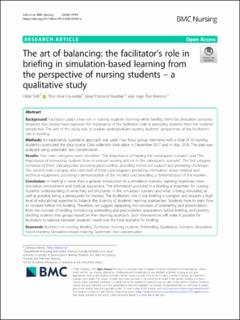| dc.contributor.author | Solli, Hilde | |
| dc.contributor.author | Haukedal, Thor Arne | |
| dc.contributor.author | Husebø, Sissel Iren Eikeland | |
| dc.contributor.author | Reierson, Inger Åse | |
| dc.date.accessioned | 2020-11-30T10:16:34Z | |
| dc.date.available | 2020-11-30T10:16:34Z | |
| dc.date.created | 2020-10-23T15:12:03Z | |
| dc.date.issued | 2020 | |
| dc.identifier.citation | Solli, H., Haukedal, T. A., Husebø, S. E., & Reierson, I. Å. (2020). The art of balancing: the facilitator’s role in briefing in simulation-based learning from the perspective of nursing students–a qualitative study. BMC nursing, 19, 99. | en_US |
| dc.identifier.issn | 1472-6955 | |
| dc.identifier.uri | https://hdl.handle.net/11250/2690140 | |
| dc.description.abstract | Background Facilitators plays a key role in nursing student’s learning when briefing them for simulation scenarios. However, few studies have explored the importance of the facilitator’s role in preparing students from the students’ perspective. The aim of this study was to explore undergraduate nursing students’ perspectives of the facilitator’s role in briefing. Methods An explorative, qualitative approach was used. Four focus group interviews with a total of 30 nursing students constituted the data source. Data collection took place in December 2017 and in May 2018. The data was analysed using systematic text condensation. Results Two main categories were identified: “The importance of framing the subsequent scenario” and “The importance of instructing students how to execute nursing actions in the subsequent scenario”. The first category consisted of three subcategories: providing predictability, providing emotional support and providing challenges. The second main category also consisted of three subcategories: providing information about medical and technical equipment, providing a demonstration of the monitor and providing a demonstration of the manikin. Conclusion A briefing is more than a general introduction to a simulation scenario, learning objectives, roles, simulation environment and medical equipment. The information provided in a briefing is important for nursing students’ understanding of what they will encounter in the simulation scenario and what is being simulated, as well as possibly being a prerequisite for mastery. The facilitator’s role in the briefing is complex and requires a high level of educational expertise to balance the diversity of students’ learning approaches. Students have to learn how to simulate before the briefing. Therefore, we suggest separating the concepts of prebriefing and presimulation from the concept of briefing, introducing prebriefing and presimulation preparation before briefing, and possibly dividing students into groups based on their learning approach. Such interventions will make it possible for facilitators to balance between students’ needs and the time available for briefing. | en_US |
| dc.language.iso | eng | en_US |
| dc.rights | Navngivelse 4.0 Internasjonal | * |
| dc.rights.uri | http://creativecommons.org/licenses/by/4.0/deed.no | * |
| dc.title | The art of balancing: the facilitator’s role in briefing in simulation-based learning from the perspective of nursing students – a qualitative study | en_US |
| dc.type | Peer reviewed | en_US |
| dc.type | Journal article | en_US |
| dc.description.version | publishedVersion | en_US |
| dc.rights.holder | © The Author(s). | en_US |
| dc.source.volume | 19 | en_US |
| dc.source.journal | BMC Nursing | en_US |
| dc.identifier.doi | https://doi.org/10.1186/s12912-020-00493-z | |
| dc.identifier.cristin | 1841843 | |
| dc.relation.project | SHARE - Centre for Resilience in Healthcare: 5091 | en_US |
| dc.source.articlenumber | 99 | en_US |
| cristin.ispublished | true | |
| cristin.fulltext | original | |
| cristin.qualitycode | 1 | |

